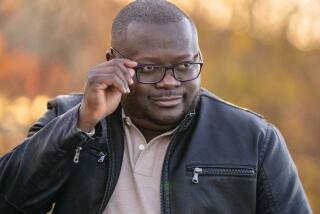BOOK REVIEW / FICTION : The Various Paths That Lead to God : DEEP RIVER <i> by Shusaku Endo</i> Translated from the Japanese by Van C. Gessel; New Directions : $19.95, 224 pages
For Western readers, Shusaku Endo has long been one of the most accessible Japanese novelists, and not just because of his straightforward style and deft, economical plotting. Endo is a Christian. He deals with issues of faith and morality that we feel at home with, and even his occasional preachiness has a familiar ring.
Indeed, Endo has often seemed alienated from his own culture. Beginning with his most famous novel, “Silence,” about Japan’s 17th-Century Catholic martyrs, he has complained that the Asian mind is a “mud swamp” in which Western ideas of good and evil, sin and redemption lose their clear-cut outlines and sink without a trace.
“Deep River,” though, signals a healing of Endo’s inner split, a reconciliation between East and West, Christianity and other faiths. His chief spokesman in the novel, the outcast Catholic seminarian Otsu, searches for “a form of Christianity that suits the Japanese mind” and concludes that Jews, Muslims, Hindus and Buddhists also have valid paths to God.
The story is about a modern-day pilgrimage. In 1984, at the time of Indira Gandhi’s assassination, a group of Japanese tourists visit Buddhist and Hindu holy places in India, notably Varanasi, a city on the Ganges where crowds of the faithful come to bathe in the river or be cremated on its shore.
Less outwardly colorful than Chaucer’s pilgrims, Endo’s tour-bus passengers all carry grave inner burdens.
Kiguchi, an ex-soldier, survived Japan’s disastrous 1944 invasion of eastern India. He is haunted by memories of the retreat through the Burmese jungle, where starving, malaria-ridden troops killed themselves with grenades and others ate the dead. He wants to hold a memorial service for them.
Isobe is mourning his wife, whom he took for granted until she died of cancer. With her last breath, she asked him to find her as soon as she was reincarnated. Impelled by the love he failed to show her when she was alive, Isobe embarks on what he knows to be a foolish quest--pursuing reports of an Indian child who claims to have been Japanese in a previous life.
Numada, a writer of children’s stories, has relied on relationships with animals during a life filled with painful separations. Dogs and birds provide him with the companionship that others find in God. Newly recovered from tuberculosis, he feels indebted to a myna bird who, he fancifully believes, has died in his place.
Mitsuko, beautiful and cynical, seduced Otsu in college in an attempt to destroy his faith. He strikes her as clumsy and ludicrous, if sincere, and she doesn’t understand why she has kept in touch with him--even now, when he lives in poverty with Hindus in Varanasi and spends his days nursing the dying who have dragged themselves to the sacred river.
Though not all the pilgrims find what they seek, all are moved by the primal experience of India.
“Deep River” is a story of a kind usually dared only by veteran writers--a direct, seemingly guileless inquiry into the meaning of life. Tolstoy’s “The Death of Ivan Ilyich” is the best-known Western example, but it’s a Japanese tradition, too: Witness Natsume Soseki’s “Light and Darkness” and Akira Kurosawa’s film “Ikiru” (“Living”).
Endo’s achievement here is mixed. Kiguchi, Isobe and Numada are realistic characters, and their stories are quietly effective. Otsu and Mitsuko, though, are the sort of people we bump into only in religious novels.
Like Gaston Bonaparte in Endo’s “Wonderful Fool,” Otsu is a clownish figure who believes he’s a failure when we know he’s actually a saint. (It doesn’t help that Gaston himself, or a clone of him, appears in “Deep River” in a secondary role.) Mitsuko’s skepticism, her self-conscious and self-lacerating lovelessness, is only too obviously a sign of her spiritual hunger.
Since the relationship between these two is at the center of “Deep River,” it suffers a little. Nor is Endo always able to resist the temptation to slight people’s everyday concerns (“cars and golf”) or to dismiss the young as superficial simply because they are young. But the ending redeems the novel with powerful images--a “river of humanity” being carried away by the all-accepting Ganges; the Hindu goddess Chamunda, wasted by disease but just as much a mother as the queenly Virgin Mary, suckling children with her withered breasts.
More to Read
Sign up for our Book Club newsletter
Get the latest news, events and more from the Los Angeles Times Book Club, and help us get L.A. reading and talking.
You may occasionally receive promotional content from the Los Angeles Times.






